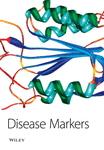HLA-DR in Brazilian Patients with Polyarteritis Nodosa (PAN) and Microscopic Polyangiitis (MPA)
Abstract
The aim of this study was to evaluate the frequency and clinical associations of HLA-DR alleles in Brazilian Caucasian patients with polyarteritis nodosa (PAN) or microscopic polyangiitis (MPA). We evaluated 29 Caucasian patients with vasculitis classified as PAN or MPA according to the American College of Rheumatology (ACR) 1990 Criteria, Chapel Hill Consensus Conference (CHCC) nomenclature for vasculitis and EULAR recommendations for conducting clinical studies in systemic vasculitis. HLA-DR alleles were typed using polymerase chain reaction-amplified DNA, hybridized with sequence-specific low resolution primers. DNA obtained from 59 Caucasian healthy blood donors were used as control. In order to evaluate if a specific HLA may have influence on the clinical profile of those diseases, we also divided the patients according to Birmingham vasculitis score (BVAS) and Five-Factors Score (FFS) at the time of diagnosis. Increased frequency of HLA-DRB1*16 (p = 0.023) and DRB4*01 (p = 0.048) was found in patients with higher disease activity at the time of diagnosis (BVAS ≥ 22). Patients with less severe disease (FFS = 0) had a higher frequency of HLA-DRB1*03 (p = 0.011). Patients with gastrointestinal tract involvement had significantly increased frequency of HLA-DRB1*11 or B1*12 (p = 0.046), B1*13 (p = 0.021) and B3 (p = 0.008). In contrast, patients with renal disease, had higher frequency of DRB1*15 or DRB1*16 (p = 0.035) and B5 (p = 0.035). In the subgroup of patients with MPA, increased frequency of HLA-DRB1*15 was found in patients with BVAS ≥ 22 (p = 0.038) and FFS ≥ 1 (p = 0.039) suggesting that this allele is associated with more aggressive disease. Antineutrophil cytoplasmic antibodies (ANCA) negative MPA patients had significantly increased frequency of HLA-DRB1*11 or DRB1*12 when compared to ANCA positive patients (p = 0.023). Our results suggest that HLA-DR alleles may influence PAN and MPA clinical expression and outcome and that in MPA they participate in the mechanisms involved in the development to ANCA.




